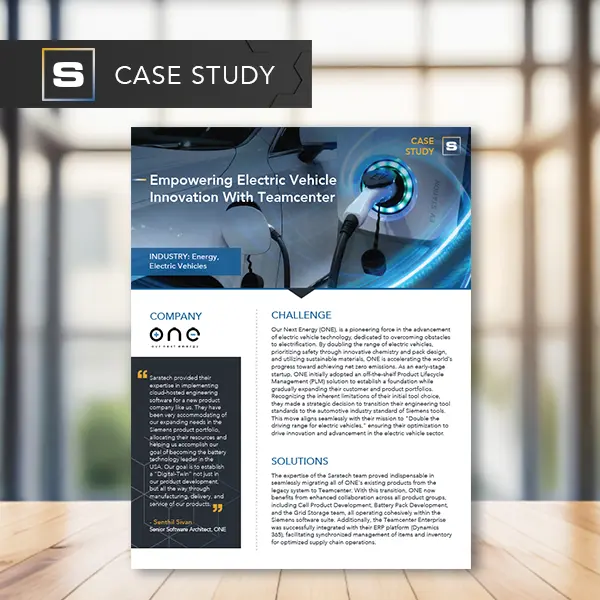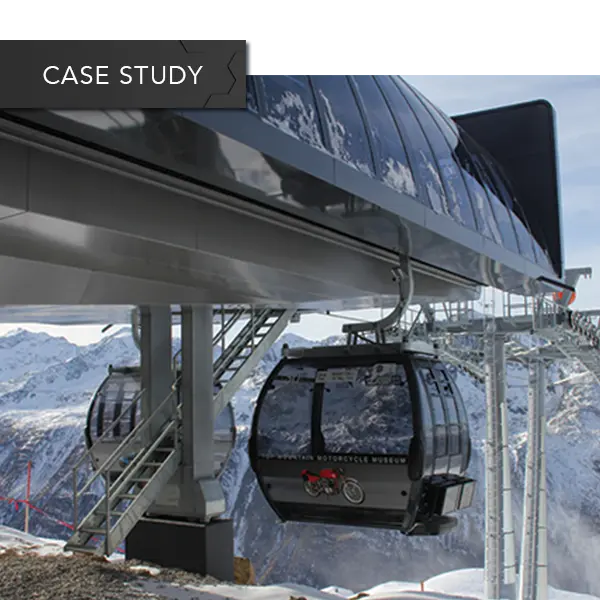New to PLM? Want to Learn How to Improve & Speed Up Your Product Development Process?
Schedule a consultation to get started. Saratech will tailor the right PLM solutions for your business needs and budget.
Plan, Develop, and Deliver Innovative Products. Discover Why Teamcenter Is the Leading Choice in PLM.
Teamcenter is the leading choice in modern product lifecycle management (PLM) software. Use digital twins to connect and optimize processes for designs, systems, software, simulation and visualization. Resolve problems before they become real. Connect people across your business. Automate and streamline product lifecycle processes. Provide visibility for everyone to make innovative product decisions. Start-ups to large enterprises - across industries - trust Teamcenter. Invest in the future with modern PLM of unmatched breadth, depth and usability.
"G2 Named Teamcenter the Best PLM Software for Companies of Any Size, Outperforming 97 Others."
What Is Product Lifecycle Management (PLM) & Why Do You Need It?
PLM stands for Product Lifecycle Management. It is a strategic business approach and a set of software tools and methodologies used by companies to manage the entire lifecycle of their products, from concept and design to manufacturing, distribution, use, and end-of-life disposal. PLM aims to optimize the product development process, improve product quality, reduce time-to-market, and enhance collaboration and communication among various stakeholders involved in the product lifecycle.
PLM software is widely used in industries such as aerospace, automotive, electronics, consumer goods, and manufacturing, where complex products require efficient data management, collaboration, and traceability. It provides a centralized platform for stakeholders across the organization and supply chain to access and contribute to product-related information, fostering innovation and driving continuous improvement throughout the product lifecycle.
Difference Between PDM and PLM
PDM
(Product Data Management)
PDM primarily focuses on the management of product-related data and documents throughout the product development process. It includes managing CAD (Computer-Aided Design) files, bills of materials (BOMs), specifications, drawings, and other engineering and design documents. PDM helps ensure data consistency and version control, making it easier for teams to collaborate on design and engineering tasks.
(Product Lifecycle Management)
PLM, on the other hand, encompasses a broader range of activities and information beyond data and documents. PLM manages the entire lifecycle of a product, from initial concept and design through manufacturing, distribution, and eventual retirement or disposal. It includes processes like project management, change management, quality management, compliance, and more. PLM aims to optimize the entire product lifecycle, including the business processes associated with it.
The Key Components of PLM
Product Data Management (PDM)
PDM involves the storage, organization, and management of all product-related data, including 3D models, drawings, documents, specifications, and other relevant information. PDM ensures that the right data is available to the right people at the right time.
Collaboration and Workflow Management
PLM systems facilitate collaboration and concurrent engineering, allowing cross-functional teams to work together efficiently on product development. It streamlines communication, automates workflows, and tracks the progress of tasks.
Change Management
PLM systems help manage changes to product designs, documents, and other data. This includes version control, change tracking, and approval processes to ensure that modifications are well-documented and properly reviewed before implementation.
Requirements Management
PLM tools enable capturing and managing product requirements throughout the development process. This helps ensure that products meet customer needs and regulatory standards.
Simulation and Analysis
PLM solutions often integrate simulation and analysis tools that allow engineers to test and validate product designs virtually, reducing the need for physical prototypes and testing.
Manufacturing Process Management (MPM)
PLM systems support the planning and optimization of manufacturing processes, including process design, work instructions, and resource allocation.
Supplier and Vendor Management
PLM facilitates collaboration with suppliers and vendors, helping to streamline supply chain processes and ensure that components meet quality standards.
Maintenance, Repair, and Overhaul (MRO)
For products with ongoing maintenance needs, PLM systems can help manage maintenance data, track service history, and improve after-sales support.
PLM Overview
Benefits of PLM
Deploying a PLM system brings numerous benefits to an organization, ranging from increased collaboration and efficiency to improved product quality, compliance, and decision-making. It enables companies to stay competitive, innovate faster, and deliver high-quality products to market more effectively.
Improved Collaboration
PLM facilitates better collaboration among cross-functional teams, including designers, engineers, manufacturers, and suppliers. It provides a centralized platform for sharing product data, documents, and information, enhancing communication and decision-making.
Efficient Data Management
PLM centralizes product-related data, ensuring that the right information is accessible to the right people at the right time. This reduces data duplication, minimizes errors, and improves data accuracy and integrity.
Enhanced Product Development Process
PLM streamlines and automates product development processes, leading to faster time-to-market and increased innovation. It helps teams manage design changes, track revisions, and efficiently release new product versions.
Better Product Quality and Compliance
With PLM, organizations can enforce standardized processes and ensure that products meet regulatory requirements and customer specifications. It enables thorough documentation and traceability of product information.
REDUCED COST AND WASTE
PLM helps optimize product development processes, reducing rework, scrap, and unnecessary iterations. By avoiding delays and identifying potential issues early on, organizations can achieve cost savings.
Improved Supplier Collaboration
PLM allows for better collaboration with suppliers and vendors. It helps manage supplier data, track supplier performance, and ensure timely and accurate delivery of components.
Risk Mitigation
PLM helps identify and address potential risks early in the product development process. It allows for simulation and testing of product designs, reducing the likelihood of failures and recalls.
Increased Product Innovation
PLM provides a structured environment for capturing and managing ideas and feedback from various sources. This encourages innovation and the development of new and improved products.
Simplified Regulatory Compliance
PLM systems can help manage compliance with industry standards, regulations, and certifications. It assists in documenting adherence to specific requirements, making audits and certifications more manageable.
Better Decision Making
With access to real-time data and analytics, PLM enables data-driven decision-making at every stage of the product lifecycle. This leads to more informed and effective business decisions.
Lifecycle Traceability
PLM ensures that all product-related data and activities are recorded and can be traced back to their origins. This is crucial for maintaining a comprehensive history of the product throughout its lifecycle.
Why Saratech Is an Ideal Partner for Your Teamcenter PLM Project
At Saratech we partner with industry-leading software companies to provide our customers with the right solution for their product development needs. Our customers rely on us for world-class design, analysis, manufacturing, data, and process management software recommendations and deployments to stay ahead of the competition. We provide engineering expertise, services, software, and manufacturing solutions to improve your product development experiences. We help optimize engineering processes to accelerate product development and speed up time-to-market. For a successful implementation, Saratech is your ideal partner, providing:
1
Teamcenter Experience
We have been a Siemens Teamcenter PLM partner since our founding in 2008. Over this time, we have completed dozens of successful implementations of Teamcenter PLM, including Teamcenter, Teamcenter Rapid Start, and Teamcenter X, across multiple industries.
2
Technical Proficiency
Our technical experts include architects and PLM engineers who are proficient in configuration, customization, integration with other systems, and data migration.
3
Project Management Skills
All projects include a project manager to track and maintain deliverables, schedule, and budget. The project manager also communicates status via regular customer meetings.
4
Fast Time-to-Value
Our structured implementation process minimizes install and configuration time.
5
Capture of Your Unique Needs
Every company is different, so while we use a standard, structured approach for our Teamcenter implementations, our process accommodates capture and implementation of your business processes/workflows, business scalability needs and plans, and change management maturity.
6
Training and Support Services
We offer Teamcenter training to ensure that your end-users and administrators can use the system effectively. We also have post-launch support, including a standard hyper-care period where we proactively monitor the system for the first week or two after go-live, and we offer longer term help desk support services.
Get a Quote for Your Team and Schedule a Consultation!
Teamcenter Deployment Options
Host, manage and support your Teamcenter PLM software with your IT team. We can help too.
Teamcenter on the cloud, with variety of hosting options, managed by your IT team or ours.
Deploy Teamcenter in a matter of weeks, using pre-configured workflows optimized for your industry.
Saratech Teamcenter Services
Understand current challenges, discuss requirements, and get started on the road to define your overall PLM strategy.
Transformation Strategy & Planning
Identify the best strategy to implement digital transformation for your organization. Our team will work with your stake holders and executives to clearly articulate your vision for PLM transformation, including purpose and benefits.
Define your PLM rollout strategy with detailed timeline and milestones. Coordinate and assign responsibilities and resources for a smooth rollout. Devise contingency plans to mitigate potential issues.
Every company's environment is different. Customization is necessary to get the most out of your Teamcenter deployment. We evaluate and identify inefficiencies then make adjustments to ensure your Teamcenter implementation is optimized for your organization.
Integrate Teamcenter with major MCAD, ECAD systems including NX, CATIA, Creo, SolidWorks and Inventor. Create seamless integration between Teamcenter and various systems to maximize efficiency.
Migrate your engineering data from flat files, home grown and other PLM systems into Teamcenter.
From system administration to user support, the Saratech team has the expertise and infrastructure in place to support your Teamcenter deployment. Having timely access to expert problem solvers allow your team to focus on product development.
Boost productivity with practical training on Teamcenter. Whether getting a new user up-to-speed or expanding the skills of your Teamcenter admin, Saratech will deliver the right training tailored to your requirements.
The PLM Process | Teamcenter Deployment Sequence
To determine the most suitable deployment sequence, organizations typically conduct a thorough assessment of their PLM needs, create a roadmap, and work with PLM consultants or experts to guide them through the implementation process. It is important to note that the deployment sequence can vary based on the organization's priorities, existing systems, and specific business needs. Some companies may choose to deploy additional custom or industry-specific modules based on their requirements.
A typical deployment sequence might include the following modules:
TEAMCENTER PRODUCT DATA MANAGEMENT (PDM)
The PDM module is the foundation of Teamcenter and is usually one of the first modules deployed. It involves storing, organizing, and managing product-related data, including 3D CAD models, documents, and other files. It establishes a centralized data repository and ensures that product information is accessible to relevant stakeholders.TEAMCENTER CHANGE MANAGEMENT
Once the PDM module is in place, the Change Management module can be deployed. This module focuses on managing changes to product data and processes, including change tracking, version control, and release management.TEAMCENTER WORKFLOW MANAGEMENT
Workflow Management is often deployed alongside Change Management or after it. This module enables the automation and optimization of business processes, ensuring that tasks are routed to the right people and completed in a timely manner.TEAMCENTER MANUFACTURING PROCESS MANAGEMENT (MPM)
The MPM module deals with managing manufacturing processes, such as process planning, work instructions, and resource allocation. It helps ensure a smooth transition from product design to production.TEAMCENTER REQUIREMENTS MANAGEMENT
This module focuses on capturing, managing, and tracing product requirements throughout the product development lifecycle. It helps ensure that products meet customer needs and comply with industry standards.TEAMCENTER SIMULATION AND VALIDATION
This module, if utilized, integrates with simulation and analysis tools to enable virtual testing and validation of product designs, reducing the need for physical prototypes.TEAMCENTER SUPPLIER COLLABORATION
Once the core modules are in place, Supplier Collaboration can be deployed to facilitate collaboration with suppliers and vendors, streamlining the supply chain processes.TEAMCENTER REPORTING AND ANALYTICS
The Reporting and Analytics module is often implemented alongside or after other modules to provide insights into product development processes, performance metrics, and data-driven decision-making.
Teamcenter Case Studies
Empowering electric vehicle innovation and enhanced collaboration across all product groups with Teamcenter.
Korea's leading general foods company utilizes Teamcenter's comprehensive product data management tools to increase innovation and significantly reduce costs.
Teamcenter plays a vital role in creating cutting-edge cable-drawn transport systems enabling Doppelmayr to maintain a leading global market position.




